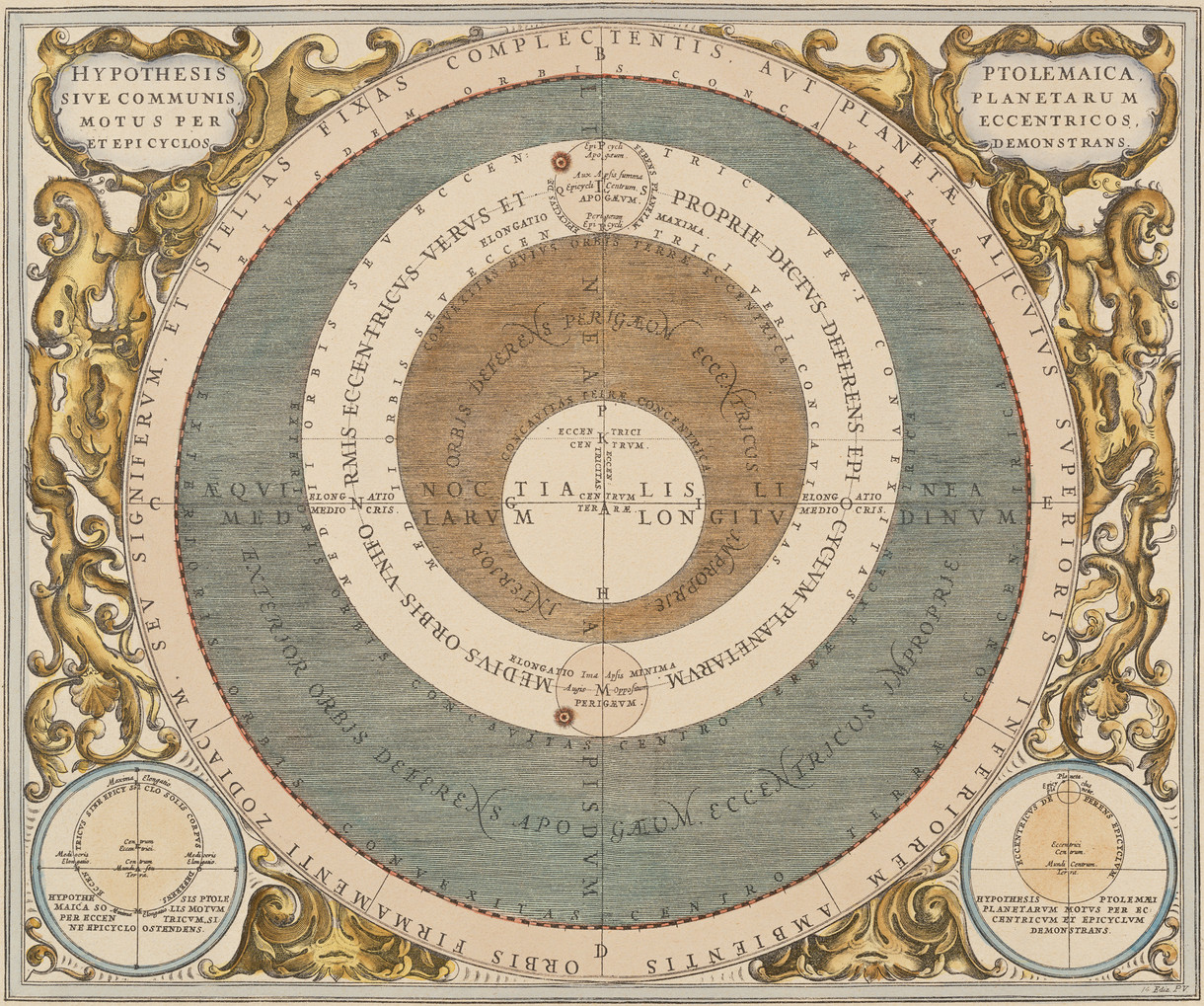Abandoned Ancestors

Photographer unknown Portrait in Antique Shop 1971. Digital file from original negative. Christchurch City Libraries archives collection, Christchurch Star archive. © Christchurch Star
Between 1971 and 1978, a selection of twelve early oil portraits came into the collection – a finely painted lineup of mostly British sitters, some named and some unidentified, whose arrival can be seen in a number of different ways.
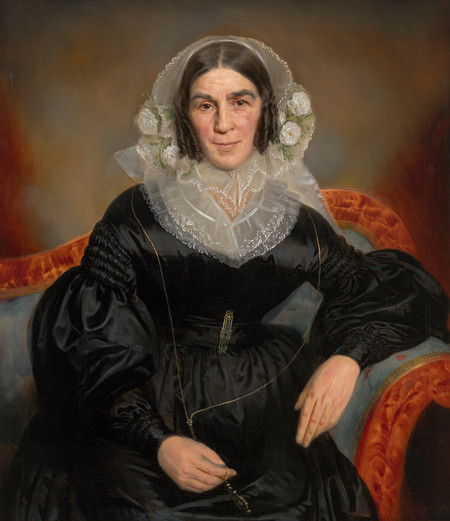
Laurent Joseph Olivier Portrait of Madame Justine Delcour 1840. Oil on canvas. Collection of Christchurch Art Gallery Te Puna o Waiwhetū, purchased, 1971
A safe enough reading would be to recognise this as a desire to catch up with more established and comprehensive Aotearoa New Zealand public art collections in Tāmaki Makaurau Auckland, Ōtepoti Dunedin and Te Whanganui–a–Tara Wellington, which all had good examples of historical portraiture, peppered with famous names. Ōtautahi Christchurch didn’t. A more iconoclastic view might see them as a way of extending ancestral European visibility and eminence, gathered relics from an imperial past, the rolling echoes of colonisation. They could represent (at least for those of British settler origin) a residual longing for a cultural centre that was utterly distant but still highly regarded. With that, they might be read as a way of increasing Old-World visual presence and providing context for New Zealand portraiture. A more generously experiential view might consider them an engaging company of well-captured exiles and castoffs, requiring no obvious elevating reason for landing here. It seems reasonable to allow all these options.
First to arrive in the collection, an unpromising icebreaker in 1971, was Laurent Joseph Olivier’s somewhat unlovely Portrait of Madame Justine Delcour, painted in Belgium in 1840. Among the few portraits to retain any thread of family connection, it joined her New Zealand descendants here in 1961, only to gather new indignities on top of old. Already bearing evidence of use as target practice by German soldiers occupying a Belgian chateau during World War I, the lace-bedecked Madame Delcour was jettisoned by her Christchurch kin as forbidding and unattractive.1 The picture was consigned to Carlton Dealers in Victoria Street, where it was declaimed by a passing journalist as “just junk”, only of value for its frame.2 This was enough, however, to alert Brian Muir, the youthful new Robert McDougall Art Gallery director, to inspect and disagree, purchasing it as “A fine piece of academic portrait painting [and] technically … superb”.3
Muir (1943–1989) started at the director’s helm in 1969 aged just twenty-five.4 A third-generation New Zealander from mainly Scottish settler stock – farmers in the Papatoetoe, Pukekohe and Waiuku districts of Auckland region – he is also known to have valued his Ngāti Pou (Waikato Tainui) ancestry.5 Muir was equipped to lead the Gallery and its collection in new, eclectic directions, with a B. A. in History and Fine Arts from Auckland University as well as teaching, broadcasting and gallery and museum experience. In 1966, at just twenty-three, he had been appointed director of the new Waiuku Museum, which was opened in a disused fire station in 1967 with much of his own extensive collection of memorabilia and Māori artefacts forming the basis of the museum.6 While there, he took in-service training with the Art Galleries and Museums Association of New Zealand, including postings at Canterbury and Auckland Museums and Auckland Art Gallery.7 From 1968, he held a brief tenure as director of the Palmerston North Art Gallery (now Te Manawa), until taking up the Robert McDougall Art Gallery director role in the following year.
The McDougall collection had developed slowly and along restricted lines under William Baverstock, part-time curator from 1949 and its first paid director from 1960 to 1969. Holding almost sole responsibility for the gallery’s operations through all those years, and with limited city council support or resources, Baverstock also had little taste for the contemporary. He was seventy-five, fifty years older than Muir, when he resigned in 1968. Early in 1969, encouraged by the council’s cultural committee, city mayor Ron Guthrey sought guidance from Eric Westbrook, a former Auckland Art Gallery director who was then director of the National Gallery of Victoria, Melbourne. Westbrook was brought across to advise on the Gallery’s future direction, including around collection development, public engagement, funding models and frameworks required, as well as to screen applicants for the role of director.8 Muir spent three weeks in October near the start of his tenure, being coached by Westbrook at the newly opened NGV in Melbourne, before taking up his duties in Christchurch proper.
Alarmed on his arrival by the Gallery’s almost complete lack of contemporary art, Muir was also discouraged by persistent fade marks showing up on the walls when works were removed for renewal of displays.9 Despite new purchases initially requiring signoff from the council cultural committee, he made steady progress, acquiring a broad range of modern works, mainly by New Zealand artists. International buying began with a series of contemporary Australian prints seen in Melbourne. Soon after his return he bought the majestic Black Painting (1969) by Ralph Hotere (Te Aupōuri, Muriwhenua) from the 1969 Group show.

Thomas Musgrove Joy Mrs T. Fraser Grove with a Favourite Dog 1849. Oil on canvas. Collection of Christchurch Art Gallery Te Puna o Waiwhetū, purchased 1976
Works by many leading contemporary New Zealand artists were collected in this period, and with a degree of gender balance that would not necessarily be expected of the time. This included painting, printmaking and ceramics, and – in the latter category – also pieces by well-known Japanese master potters. Recent prints by leading British artists were also secured alongside historical European and British prints, colonial New Zealand watercolours and early twentieth-century New Zealand artists. In his keenness to expand access and opportunities for public connection, he entered a new collecting field in classical antiquities between 1972 and 1975, largely in response to requirements of the New Zealand secondary schools’ art history curriculum. His source was Charles Ede, a newly established Mayfair, London antiquities dealer, whose slim catalogues facilitated the Antipodean flow of nine ancient world pieces originating from Egypt, Greece and the Roman empire. Muir also made gains from having his recent directorial assistant Jonathan Mane-Wheoki (Ngāpuhi, Te Aupōuri, Ngāti Kurī, English) stationed for art history studies in London, resulting in the addition of works by artists including Edgar Degas, Max Beckmann, Paul Cézanne, Bridget Riley and Andy Warhol between 1973 and 1975.
In 1976, Muir begin acquiring early British portraits through locally available works. The first (and among the best) was acquired for $1,700 from R. G. Bell Auctions in Kaiapoi, adding to the collection a portrait of an aristocratic young woman adorned in fine silk, satin and muslin, with ribbons, lace and heavy gold, and joined by a large black Newfoundland dog. Thomas Musgrove Joy’s Mrs T. Fraser Grove with a Favourite Dog had been shown at the Royal Academy in London in the summer of 1849, when it was described in The Illustrated London News as “clever”. Two years earlier, Katherine Grace O’Grady of Castle Garde, County Limerick, had married Captain T. Fraser Grove of the Inniskilling Dragoons, then stationed in Ireland. When her portrait was shown in London, she was twenty and had one daughter, was expecting a second, and had recently been presented before Queen Victoria at St James’s Palace. Census records from across the decades show her and her husband living at Seagry House in Chippenham, near Bath, with a small army of servants: coachmen, butlers, footmen, cooks, housekeepers, kitchen maids, nurses, lady’s maids, laundry maids, dancing mistresses and Swiss governesses all keeping the operation running. How her portrait came to be separated from descendants is unknown.
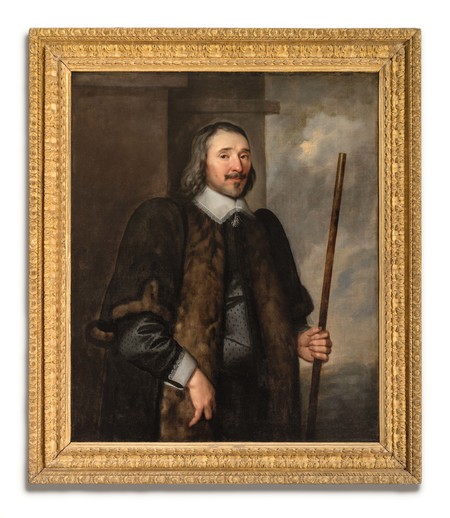
Robert Walker Portrait of a Courtier c. 1653. Oil on canvas. Collection of Christchurch Art Gallery Te Puna o Waiwhetū, purchased 1976
Different histories emerge from the next portrait purchase of 1976, sourced from John Dixon Antiques in Remuera, who were known to procure stock from England. Presenting a stern official from the 1650s English Civil War era with a wooden staff and vigilant eye, Portrait of a Courtier arrived without provenance. In 2016, it was attributed to Robert Walker, an artist long associated with Oliver Cromwell and recorded by a near-contemporary as responsible for “the portraits of that usurper, and almost all his officers, both by sea and land”.10 Painted near the beginning of Cromwell’s turbulent five-year rule as Lord Protector of the Commonwealth of England, Scotland and Ireland, the subject of the portrait is still unidentified.
Seven more British portraits reached Christchurch from the bottom of the South Island in 1976 and 1977, all purchased from long-established Waihōpai Invercargill watchmaker and jeweller N. J. M. Rein Ltd., who had sourced them from a specialist dealer gallery in the tiny village of Iden in East Sussex, England.11 The first group comprised Sir William Beechy’s undated portrait of Mrs Idle; Sir Henry Raeburn’s Mr Drake and Mrs Drake (1795); and a portrait of Vice Admiral Robert Duff (1764), riskily attributed to Sir Joshua Reynolds. All retained some provenance, most including names of sitters’ descendants.
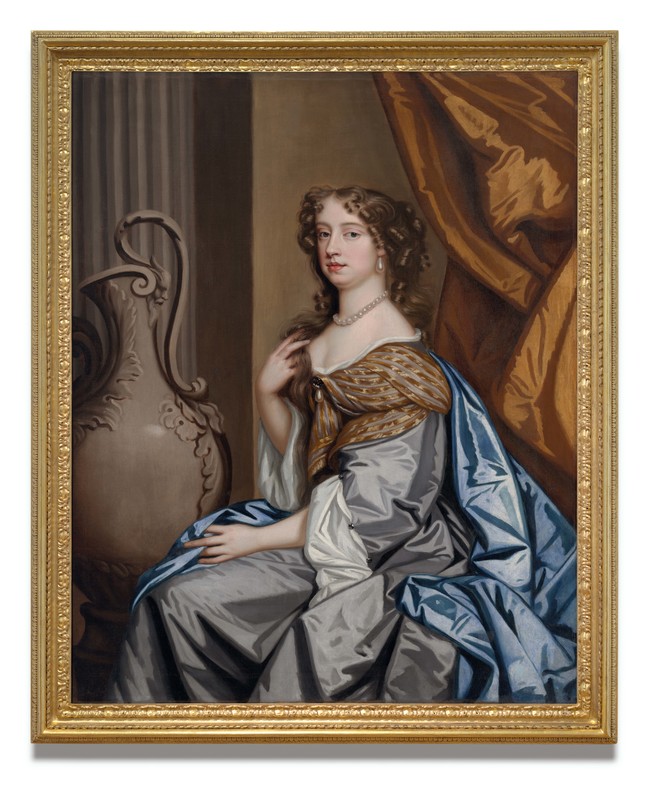
Studio of Peter Lely Portrait of Frances Teresa Stuart, Duchess of Richmond and Lennox c. 1670. Oil on canvas. Collection of Christchurch Art Gallery Te Puna o Waiwhetū, purchased 1977
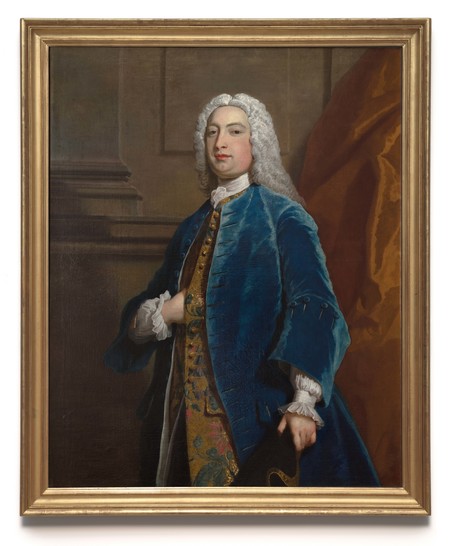
Joseph Highmore Thomas Budgen, MP for Surrey 1751–1761 1735. Oil on canvas. Collection of Christchurch Art Gallery Te Puna o Waiwhetū, purchased 1977
Three more Invercargill castaways arrived in 1977, starting with a plainly titled Duchess of Richmond, attributed to the ‘Studio of’ Sir Peter Lely. Lely was a German-born Dutch artist who settled in England in 1643, became the leading portraitist to the royal court, and ran a large studio filled with assistants. Portrait of Frances Teresa Stuart, Duchess of Richmond and Lennox pictures the Paris-born courtier who became maid-of-honour to the exiled Henrietta Maria, widow of Charles I. Frances Stuart arrived in London in 1663 after the Restoration and was appointed lady-in-waiting to Queen Catherine of Braganza, whose notorious dallying husband Charles II became obsessed by “La Belle Stuart”, as she was widely known. Frances is known to have upset the king by rejecting his advances and intentions to divorce and make her his queen, instead marrying Charles Stewart, Duke of Richmond and Lennox. Though famous for this refusal, other accounts claim that she bore the king’s child. She is known to have modelled for the figure of Britannia on a 1667 commemorative peace medal – an image thereafter repeated on British coinage. Somewhat less grandly, her portrait when it reached the Gallery had a pencilled note on the back reading “Book room over fireplace”.
The remaining Invercargill portraits captured a bewigged gentleman in a blue velvet coat and a young woman cradling a lamb. When cleaned, the former disclosed a faint signature and date, ‘J. Highmore pinx: 1735’. The haughty gentleman’s identity was discovered in 2010 through contact with Alison S. Lewis, an American scholar who completed her PhD on Joseph Highmore in 1975. This enabled his identification as Thomas Budgen, an Oxford-educated London factory owner, and later MP for Surrey, and the second portrait as his wife Penelope Smith, now attributed to Maria Verelst. In 1727, a newspaper marriage notice described them as “a Sugar-Baker in Goodman’s Fields” and “a Gentlewoman of a very great Fortune”. Both had gained capital through family and business investments, largely linked to slavery and sugar plantation ownership on Nevis in the West Indies. Dr Lewis’s notes recorded that in 1955, the portraits had been in private, family hands in Edinburgh, presumably with the brutal origins of the Budgen’s wealth long forgotten.

Artist unknown, after Cornelius Janssen van Ceulen Portrait of the Poet Edmund Waller, Esq. 17th century. Oil on canvas. Collection of Christchurch Art Gallery Te Puna o Waiwhetū, purchased 1978
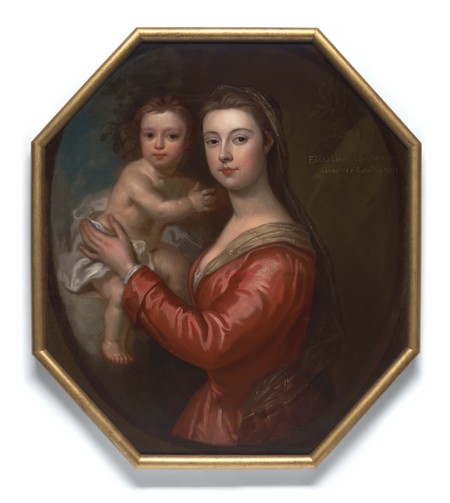
Charles Jervas Elizabeth, Lady Oxenden, Daughter of Edmund Dunch c. 1721. Oil on canvas. Collection of Christchurch Art Gallery Te Puna o Waiwhetū, purchased 1978
The last portraits bought before the end of Brian Muir’s tenure in 1979 were Portrait of the Poet Edmund Waller, Esq., after Cornelius Janssen van Ceulen; and Elizabeth, Lady Oxenden, Daughter of Edmund Dunch (c. 1721), by Charles Jervas. Both were purchased from another visit to the Remuera antique shop in 1978 – the first was titled Portrait of an Unknown Man until 2009, when a British visitor recognised here a copy of the original 1629 portrait still in family hands in England. Edmund Waller was a British politician and poet, elected to Parliament in his late teens; twenty-three when the original was painted, he was one of the wealthiest men in England. Though still recognised for his poetry, he is also recalled as an adept political operator, changing allegiances according to shifts in power through stormy times. Virtually hidden is that he was a founding member in London in 1661 of the Council for Plantations, directing colonial affairs in America and the West Indies, again including slavery and sugar production. This sits awkwardly alongside his marriage in 1644 to Mary Bracey, “said to have been a coloured Barbadoes [sic] girl, dau. of Mr Bracey / Breaux / Bresse of Thame”, with whom he had thirteen children.12
Further enigmas arise through the history of Elizabeth Oxenden, whose portrait with her son Henry is inscribed “Elisabeth, Lady Oxenden, Daughter of Edmd Dunch”. Elizabeth was the eldest daughter of Elizabeth Godfrey, maid of honour to Queen Anne, and Edmund Dunch, master of the royal household, who died in 1719. Deemed a wealthy heiress, she married George Oxenden, a sitting MP and future Lord of the Admiralty, the following year aged seventeen. In 1721, the leading London painter Charles Jervas was commissioned to paint her, evidently celebrating the birth of an heir. Her husband, however, became a notorious squanderer and profligate, entering ruin and bankruptcy as well as fathering children to other women, one to the Prime Minister’s daughter-in-law and two to Elizabeth’s sister, who was married to his closest friend and died in childbirth. Much is written about George, to whom – despite betrayal and undoubted heartbreak – Elizabeth evidently remained faithful to the end. Her last will and testament, recently found and dated 1779, concludes with her desire “to be buried by my dear and beloved husband Sir George Oxenden.”13
Remaining part of the broader development of the collection under Brian Muir after a long period of stasis, all these portraits belong to a specific moment in the Gallery’s history. Nearly fifty years later there remains a place for them and their stories, even if these need to be coaxed, prised and extracted rather than tumbling out unsolicited. Appearing at first perhaps as haphazard arrivals and presences, collected from varying sources and through obscure circumstances, all offer illuminating threads to worlds left behind. As ancestral portraits that once held honour but instead came to be castoffs, far distant from places of origin, they yet retain a sense of memory and connection to these worlds. While speaking to the strangeness of culture, ambitions and lives transplanted, they also carry their own tales – personal and broadly historical – shadowing, echoing, reverberating with the past, long after paint-loaded brushes have flown across taut canvas.








